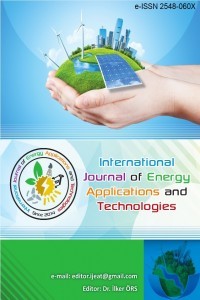Leakage detection in underwater oil and natural gas pipelines using convolutional neural networks
Leakage detection in underwater oil and natural gas pipelines using convolutional neural networks
Convolutional Neural Networks, Underwater Object Detection, Underwater Oil and Natural Gas Pipelines Underwater Pipelines Detection, Unmanned Underwater Vehicle,
___
- S. Amidi, "https://stanford.edu/~shervine/l/tr/teaching/cs-230/cheatsheet-convolutional-neural-networks," [Online].
- C. Roemer, "https://cp4space.wordpress.com/page/2/," [Online].
- F. Chollet, Deep Learning with Python, Manning, 2017.
- H. A. Song and Y. Lee, "Hierarchical Representation Using NMF," International Conference on Neural Information Processing, pp. 466-473, 2013.
- A. Gülcü and Z. Kuş, "Konvolüsyonel Sinir Ağlarında Hiper-Parametre Optimizasyonu Yöntemlerinin İncelenmesi," Gazi Üniversitesi Fen Bilimleri Dergisi , pp. 503-522, 2019.
- İ. Kurtoğlu, G. A. Canlı, M. O. Canlı and Ö. S. Tuna, "Dünyada ve Ülkemizde İnsansız Sualtı Araçları(İSAA-AUV&ROV) Tasarım ve Uygulamaları," GİDB|DERGİ, vol. 4, pp. 43-75, 2015.
- M. Dongfeng, C. Gui, Y. Lei and L. Zhigang, "Deepwater Pipeline Damage and Research on Countermeasure," Aquatic Procedia, pp. 180-190, 2015.
- K. A. Uysal and N. Cansever, "Doğalgaz ve Petrol Boru Hatlarında Hidrojenin Neden Olduğu Çatlamalar," in 3rd International Non-Destructive Testing Symposium and Exhibition, İstanbul, 2008.
- M. Graf, A. Liessem and K. R. Pöpperling, Review of the HIC Test Requirements for Linepipe over the years 1975 to 2000, Germany: Europipe, 1999.
- A. Jernelöv, "The Threats from Oil Spills: Now, Then, and in the Future," AMBIO, no. 39, pp. 353-366, 2010.
- Yayın Aralığı: Yılda 2 Sayı
- Başlangıç: 2014
- Yayıncı: İlker ÖRS
Experimental investigation of heat transfer in aluminum wings with NACA 4040 profile
Adnan BERBER, Muhammed YETİMOĞLU
Examination of parametric cycle analysis of a turbofan engine with Python code
Ayşe Nur DİŞLİTAŞ, Bilge ALBAYRAK ÇEPER
Using alternative energy in aircraft
Investigation of the combustion and fuel properties of slurry fuels formed by biomass and coal
Leakage detection in underwater oil and natural gas pipelines using convolutional neural networks
As a case study, energy analysis application of a hotel business in private sector
Cihan BAYINDIRLI, Mehmet ÇELİK
Autonomous solar panel cleaning robot with rubber wheeled and air-absorbing motor
